 Toyota Yaris: Fold - down rear seat
Toyota Yaris: Fold - down rear seat
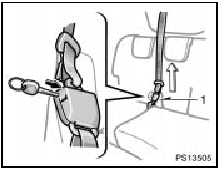
BEFORE FOLDING DOWN REAR SEATS
1. Before folding down the seatback, disconnect the center seat belt to prevent damage.
Insert the key into the hole on the buckle to release tab 1 (with hook end), and allow the belt to retract.
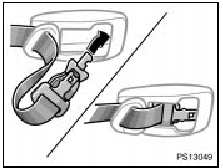
2. Insert the tabs of the center seat belt into the cover. Make sure the tabs are securely locked in the cover.
NOTICE.
The seat belt tabs must be stowed before you fold the seatback.

3. Make sure the outer seat belt passes through the hanger when folding the seatback down.
This prevents the shoulder belt from being damaged.
CAUTION.
The seat belt must be removed from the hanger when the seat belt is in use.
NOTICE.
The seat belt must be stowed before you fold the seatback.
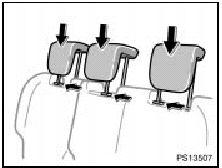
FOLDING REAR SEATS (split seat)
1. Lower the head restraint to the lowest position.
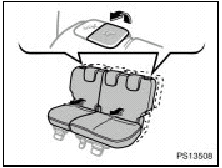
2. Pull the seat position adjusting liver up. Then slide the rear seat fully forward.
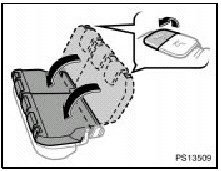
3. Pull the seatback angle adjusting lever up and fold the seatback down.
Each seatback may be folded separately.
CAUTION.
When returning the seatback to the upright position, observe the following precautions in order to prevent personal injury in a collision or sudden stop: Make sure the seatback is securely locked by pushing forward and rearward on the top of the seatback.
Failure to do so will prevent the seat belt from operating properly.
Make sure the seat belts are not twisted or caught in the seatback and are arranged in the proper position and are ready to use.
NOTICE.
Do not pull the pocket that stores the seat belt comfort guide when returning the seatback to the upright position.

4. Flip over the deck board.
This will enlarge the luggage compartment as far as the seatbacks. See “Cargo and luggage” for precautions to observe for loading luggage.
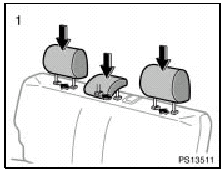
FOLDING REAR SEAT (non-split seat)
1. Lower the head restraint to the lowest position.
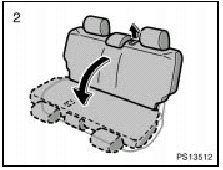
2. Pull the seatback angle adjusting lever up and fold the seatback down.
Each seatback may be folded separately.
CAUTION.
When returning the seatback to the upright position, observe the following precautions in order to prevent personal injury in a collision or sudden stop: Make sure the seatback is securely locked by pushing forward and rearward on the top of the seatback.
Failure to do so will prevent the seat belt from operating properly.
Make sure the seat belts are not twisted or caught in the seatback and are arranged in the proper position and are ready to use.
NOTICE.
Do not pull the pocket that stores the seat belt comfort guide when returning the seatback to the upright position.
 Rear seats
Rear seats
—Rear seat precautions
CAUTION.
Do not adjust the seat while the vehicle is moving.
Be careful that the seat does not hit a passenger or luggage.
Be careful not to get your hands or feet pinch ...
 Head restraints
Head restraints
Front seat
Rear seat (split seat)
Rear seat (non-split seat)
For your safety and comfort, adjust the head restraint before driving.
To raise: Pull it up.
To lower: Push it down whil ...
See also:
If you lose your keys
You can purchase a new key at your Toyota dealer if you can give them the
key number. If your vehicle is equipped with the engine immobilizer system, the
dealer will also need your master key.
...
Wireless remote control
The wireless remote control can be used to lock and unlock the vehicle.
Type A
Locks all the doors
Sounds the alarm (press and hold)
Unlocks all the doors
Pressing the button unlocks the driver ...
Engine immobilizer system
The engine immobilizer system is a theft prevention system. When you insert
the key in the ignition switch, the transponder chip in the key’s head transmits
an electronic code to the vehicle.
...
